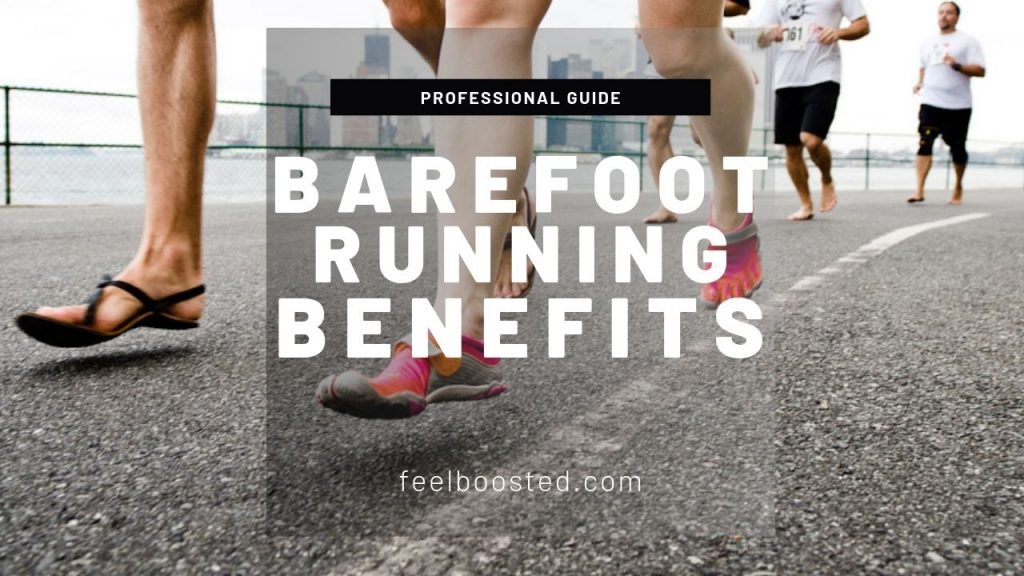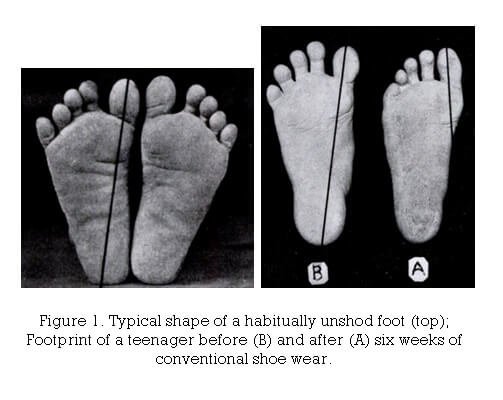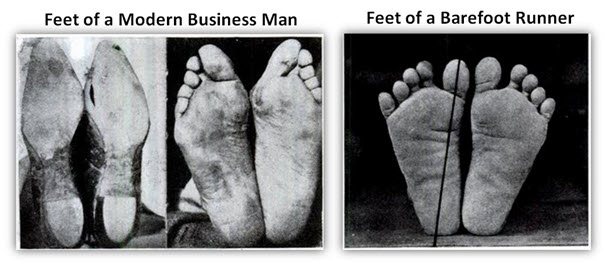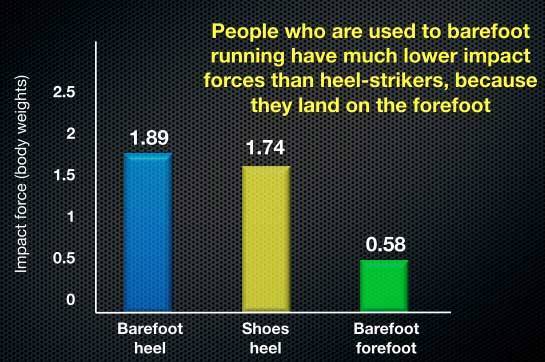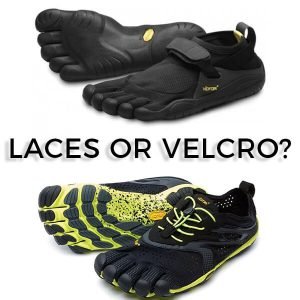Here is something to ponder upon as you continue reading on;
The human foot is an extraordinary machine made up of numerous ligaments, tendons, muscle groups not to forget up to 26-bones that are perfectly capable of absorbing the collision forces between our bare feet and ground.
Another fact is, before the invention of running shoes, people ran berefoot miles after miles in search of food, shelter, and whatever else they did back in the day, but there are no signs of foot damage cataloged in any archeological discoveries of early man.
Like everything else, running as we know it has completely changed.
Studies by a professor of human evolutionary biology at Harvard University known as Daniel Lieberman suggest that runners who go barefoot or use minimal footwear like those in Ancient Greece that are lighter than traditional running shoes use less energy.
11 Health Benefits of Running Barefoot
Barefoot running has numerous benefits.
However, it works best as a small part of a broader workout plan that should be incorporated with strength and flexibility routines to ultimately strengthen your feet, improve balance, form, and most importantly, mitigate injuries.
Once you get used to it, you will enjoy the following benefits of barefoot running or running with barefoot shoes;
- It makes you feel more in tune with your environment
- Barefoot running shoes or running barefoot allows you to land on your forefoot or midfoot, which alleviates stress injuries such as fractures and plantar fasciitis
- Running barefoot on a soft surface like on san require extra work and increases the demands on your feet, heart and lungs, consequently, leads to increased calorie burn
- Running barefoot improves your balance and proprioception
- It enhances flexibility by stretching and strengthening the calf muscles and the Achilles tendon
- Barefoot running has been shown to reduced risks of injury, tendinitis, and calf strains
- It can help you run faster as it activates the small muscles in the hips, legs, and ankles to a greater extent
- It offers improved running economy, which basically is how much energy you expend when running any given pace – think long distant runners
- Barefoot running helps you land on the midfoot area, which makes it easier to push and lift off; consequently, it can help you develop a more flexible, comfortable and natural pace and gait since your entire body is adequately aligned
- It activates the muscles that are responsible for balance and coordination
- When your feet become used to being bare, you gradually begin to wake otherwise dormant muscles in the feet and upper legs. By so doing, you can significantly improve blood oxygenation, circulation, immune responses even reduce the likelihood of developing varicose veins
Running shoes offer protection cuts and abrasions, plus they can cause injuries because they alter the natural biomechanics of your feet.
Barefoot running on the hand has a lot of health benefits, but if you are used to running in shoes, you should approach this concept slowly and with care.
What Is Barefoot Running, and Is It Worth Trying?
If you are ready to join the barefoot running movement, be prepared to toss aside your ergonomic trainers and start running either without shoes or barefoot-feeling shoes, because that’s the idea behind this concept.
Barefoot running is not a new fad that just pop-up and as much as many people have embraced the trend today, it’s certainly not for everyone.
Some runners who have been a little too eager to lose their trainers have wound up in a pickle suffering various injuries ranging from stress fractures and Achilles tendinitis, among others.
But in order to reap its benefits, you need to ease yourself into barefoot running because, in as much as it produces undeniably positive results, the last thing you need is to find yourself bed-ridden from injuries sustained by poor form.
Does Barefoot Running Prevent Injuries?
Being unshod is normal for humans; in fact, our ancestors ran and walked without shoes for millenniums before footwear was invented.
Dr. Lieberman notes in 2012:
Dr. Daniel Lieberman research on injury rates, published in Medicine & Science in Sports & Exercise, reported “a 2.6-times greater chance of having an injury” from running in traditional shoes than running completely barefoot or minimally shod. “It’s a huge difference,” he says.
“As far as I know, it’s the biggest effect ever shown on running injury.”
However, while there are studies that indicate that modern running shoes may be causing us more harm than good, realistically speaking, there are some people who have taken up barefoot running and unfortunately, developed entirely new aches and injuries to their feet and lower legs.
Which begs the question, why are some succeeding in this activity while others, well, not so much?
It all has to do with how long you run barefoot (mileage), your running form, overall body weight, as well as other variables such as your biomechanics, your predisposed to foot injuries particularly if you’re used to wearing regular running shoes and the transition to barefoot-style running, is taking.
Source: Does Barefoot Running Prevent Injuries?
Featured article: How to Choose Minimalist Running Shoes
Running without shoes may have been a natural process for cave-dwellers, but you may want to ease into this new experience gradually in order to mitigate any injuries because there are millions today who have been running barefoot with no reported injuries.
So, you can set your feet free, but do your due diligence by ensuring that you go about it the right way. Keep reading and see how to do it because if done incorrectly or too quickly, you will be a statistic.
How Do I Transition to Barefoot Running?
Experienced barefoot runners and coaches will tell you that you can certainly enjoy the benefits of barefoot running while avoiding the pitfalls but you need to prepare your body first.
For example, do you walk barefoot in the house or outside your yard or on surfaces like grass, soft dirt, or firm sand?
Your feet need to get acclimatized to the feel of different surfaces because as it were, it takes about a year for your feet, ankles and upper legs to fully adapt to running without shoes.
Before kicking your trainers to the curb and start running without shoes, you may want to try barefoot running shoes for the first few weeks as you get comfortable with the close ground contact that will allow the muscles in your feet to strengthen.
Consider the following transitioning tips to barefoot running;
- Walk barefoot or in your minimalist shoes inside and outside your home for a few hours a day for two weeks
- Slowly increase the distance and amount of time you spend shoeless, and if you’re brave, you can try walking barefoot to the nearest store for the next few weeks.
- The key to running barefoot is all about form and function. So, once you are ready to start running pay attention to how your feet are contacting the ground
- Your first run will be challenging at first but to help you keep going, ensure that you perform daily exercises that will help relax any tight muscles and tendons and build long-term foot strength and resiliency. Workouts such as the toe extensor stretch, the big toe stretch, the hammertoe stretch, the rolling ball exercise are a few that will help strengthen your intrinsic foot muscles.
Is Barefoot Running Good for You?
Running without a pair of shoes worth a few hundred dollars has grown in popularity, and it’s an activity that has been shown to help mitigate various chronic and performance injuries.
When done correctly, such as altering your stride or gait and landing on the front of the foot to diffuse the ground-foot impact can help familiarize you and your feet to running without shoes.
The very best part about running barefoot is that you will activate various micro-muscles you didn’t even know you had and as your bare feet get used to variances in terrain, you will begin to increase in strength, gaining more balance and agility.
The goal is to listen to your body continually including how the ground feels under your feet when running all the while focusing on the right stride length as well as finding just the right place for your foot to land at the same time.
Sounds easy, right?
Start with Vibrams: Which Vibrams Are Best For The Gym, Everyday Use and Running?
Barefoot Running: Should You Try It?
Barefoot running is healthy, but it can be quite absorbing, it takes time, and concentration plus you are more likely to suffer a few cuts and abrasions, but ones you have it locked-in, your mind, body, soul, and feet will thank you for it.
If you are ready to take your workout routine to a whole new level of health, you may want to try barefoot running, because it feels great. To prevent the likelihood of injuries;
- Don’t over stride as it this will add undue stress to the calf muscles, Achilles tendon, and the arch of the foot
- Run on a hard, even surface that is free of debris
- Ensure that your landing is springy, gentle, relaxed and compliant while flexing the hip, knee, and ankle
Useful info:
Vibram Fivefingers : How to Choose/Buy the Right Vibram Five Fingers
The Benefits of Toe Socks – Why Wear Toe Socks?
Vibram Lawsuit – Are Vibram Five Fingers Bad for You?

